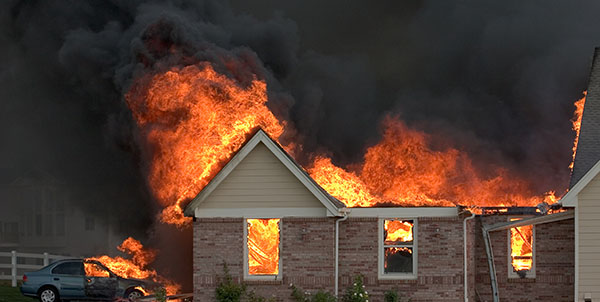The Dangerous Consequences of a House Fire
A house fire may be one of the most frightening scenarios any homeowner can imagine. A moment of carelessness can destroy a lifetime of treasured mementos and cause serious injury or death. While the actual flames are dangerous, the smoke they produce is the leading cause of death and property damage in a house fire.
When a house fire occurs, you need to evacuate your home immediately without worrying about limiting the damage or even calling the fire department. Even if you are in an area of your home where the flames aren’t, your life is in danger. The smoke and fumes created by the fire are extremely dangerous. It is very important for homeowners to create an evacuation plan in case of a fire and practice it with their families to ensure that everyone knows how to evacuate safely. The evacuation plan should include multiple exits because you never know which exit might be blocked by a fire. Once you have evacuated, you can call the fire department.
The following are the most dangerous consequences of a house fire:
Toxic Fumes
Smoke inhalation causes more deaths in house fires than actual flames. Carbon monoxide, hydrogen cyanide, and phosgene irritate the lungs and can cause confusion and disorientation, making it more difficult to get out of the burning building.
Smoke fumes are especially dangerous because they consume or replace the oxygenOxygen is a chemical element essential for combustion and li... More in the air. When escaping the home during a fire, stay as low to the ground as possible to avoid inhaling smoke fumes. The following contents of smoke can incapacitate or kill those who inhale them:
- Particles: Smoke may contain small particles of burned or partially burned substances that can build up in the lungs and irritate eyes. Some particles may be toxic.
- Vapors: These droplets of liquid are toxic if inhaled and they can also be absorbed through the skin.
- Toxic gases: Carbon monoxide is present in all smoke and it is fatal because it replaces oxygenOxygen is a chemical element essential for combustion and li... More in the blood stream. Hydrogen cyanide is formed when plastics are burned, and this gas can disrupt cellular respiration. The burning of synthetic materials forms phosgene which can irritate your eyes and throat and cause pulmonary edema.

Structural Damage
Many house fires do not destroy the entire structureStructure refers to the framework or components of a buildin... More, although they do leadLead is a heavy metal that can be toxic to humans, especiall... More to smoke and water damage throughout the house. A cooking fire, for example, may be contained to the kitchen and perhaps one or two adjacent rooms, but that doesn’t mean that the rest of the house will be habitable. Smoke can quickly penetrate other areas of the house, leaving thick deposits on walls and furniture. Smoke can also damage the foundation and structural supports throughout your home, making it vulnerable to collapse.
Water damage is a common and unavoidable consequence of a house fire. When firefighters enter your home to put out the flames, they aren’t going to worry about what else gets wet. Their primary concern is containing the fire. As a result, the water used to extinguish the flames will get absorbed by building materials which will further weaken them and increase the risk of collapse.
Never re-enter a fire damaged building until a professional fire damage restoration team has inspected it. They will examine the structureStructure refers to the framework or components of a buildin... More to ensure that it is safe to enter the building. Once they have verified that the home has not sustained structural damage, they will assess the smoke and water damage.
Restoring Your Home After a Fire
Rebuilding the damaged areas of your home may be the first thing on your mind. A qualified fire damage restoration company will begin by performing a thorough safety inspectionInspection is the careful examination and assessment of a pr... More. During this process, they will assess the damage and form a complete restorationRestoration is the process of returning a property to its pr... More plan that includes repairing structural damage and cleaning and deodorizing areas of your home that may not have been directly impacted by the fire. You can trust these professionals to fully restore your property using state-of-the-art equipment and return your home to its pre-fire condition.












